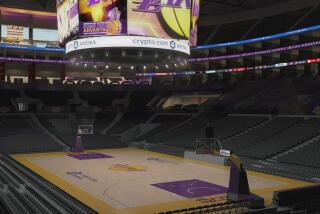The New Cleveland Gateway
- Share via
CLEVELAND — You can call the Cleveland Indians’ new home “Jacobs Field,” or “Gateway,” or simply “Indians Park.” Just don’t call it a stadium.
A stadium, you see, is what the Indians left behind: huge, musty old Cleveland Stadium, whose countless empty seats served to remind the players every night how bad they were.
“A stadium is a multipurpose facility. This is a baseball park,” said Bob DiBiasio, Indians vice president of public relations.
DiBiasio skipped his annual six-week trip to spring training this year because there was so much work to be done back home preparing the park for an April 2 exhibition game against Pittsburgh and the April 4 opener against Seattle.
But it is exciting work for him and for all the Indians’ employees, hopeful the new park heralds a new era for a team desperately in need of one.
The Indians haven’t won a pennant since 1954.
“I think it’s going to be the thing that really turns the corner for us,” said pitcher Charles Nagy. “Anybody who goes to work every day knows that the atmosphere is a big key.
“When you used to go down to the old ballpark, you had to drag yourself there. It’s big, old, cavernous. It’s dismal. So you’d go to the park as late as possible. With the new place, everybody’s really excited.”
The 42,400-seat, natural-grass park is part of a $425 million project that includes a 20,750-seat arena, built to lure the NBA’s Cleveland Cavaliers back downtown from neighboring Summit County. The arena will open this fall, in time for the Cavs’ 1994-95 season.
Both facilities were squeezed between two busy streets at the southern edge of downtown, on 28 acres that formerly held rundown warehouses and shops. The project is being paid for by a complicated public-private financing package anchored by a 15-year tax on cigarettes and alcohol sold in Cuyahoga County.
County voters approved the tax in 1990 to keep the Indians from leaving town. The county will own the place once all the loans and bonds are paid off.
The Gateway Economic Development Corp., a non-profit organization formed to oversee the project, left the naming of the buildings to anyone willing to pay a total of $20 million for the privilege. On Wednesday, trustees accepted the $13.8 million bid of Indians owner Richard E. Jacobs to call the ballpark “Jacobs Field” for the next 20 years. The arena naming rights remain to be sold.
In any event, it may be difficult to shake the “Gateway” label that has been used to identify the project for several years. And the Indians’ literature for this season, printed before any name was chosen, refers to the baseball field as “Indians Park.”
Because the architects--who also designed Baltimore’s Camden Yards and Chicago’s new Comiskey Park--had so little room to work with, the park’s dimensions can fairly be described as quirky.
The fence in left field is 19 feet high and angles from 325 feet deep down the line to a point in left center that is 410 feet from home plate. The 8-foot fence in dead center is 405 feet deep, and the 8-foot right-field fence goes from 375 feet in the power alley to 325 feet down the line.
There are 119 luxury suites that lease for $45,000 to $100,000 a year. The most expensive are 10 small apartments at field level between the dugouts, some of them situated closer to home plate than the pitcher.
The cheapest seats, $6 each, are in the left-field bleachers and the upper deck in right.
A statue of Hall of Fame pitcher Bob Feller will greet fans at one of the busiest entrances.
Among the features are concession stands with views of the field, so fans can go for refreshments without missing a pitch; seats down the lines that are angled toward the infield, to avoid neck strain; seating for 400 handicapped people; a children’s play area behind the right-field stands; and a beer garden (14 varieties on tap) behind the left-field stands.
Smoking will be restricted to six areas, none in view of the playing field. That has angered some smokers who paid the special tax that’s funding the complex.
Indians players, meanwhile, will find a clubhouse that is more than three times the size of their cramped quarters at Cleveland Stadium. Included are a steam room, a sauna, a weight room, a hydrotherapy area with whirlpools and a “swim-in-place” pool, a video room, and batting cages close enough to the dugout to let designated hitters keep loose by taking extra swings during a game.
“When you spend a million dollars on a player, you want to have a place where they can stay in condition,” DiBiasio said. “We have 11 guys who live in the Cleveland area year-round now, and the whole reason is they knew this was coming.”
Unquestionably, it’s an improvement over Cleveland Stadium, which remains the home of the NFL’s Cleveland Browns. But is it enough to help the Indians contend in their new and presumably weaker division, the American League Central?
Fans apparently think so. A full month before the opener, they had already bought nearly 1.8 million tickets; the franchise attendance record of 2.6 million, set in 1948, seems sure to fall.
“I think it makes a big difference,” catcher Sandy Alomar said. “It’s going to make players come to the ballpark with no excuses.”
More to Read
Go beyond the scoreboard
Get the latest on L.A.'s teams in the daily Sports Report newsletter.
You may occasionally receive promotional content from the Los Angeles Times.










